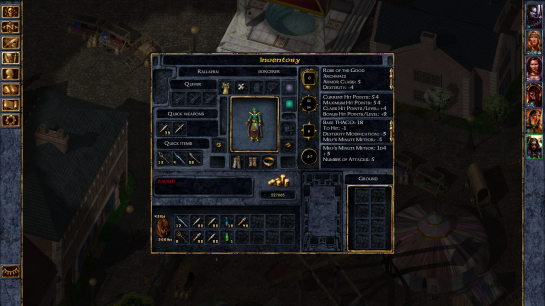
The aim of my Blogging From A to Z Challenge is to find the origins of online games, some relatively modern and some with ancient roots. Gaming might well be a modern take on an art that is almost timeless – storytelling. A perfect excuse for a writer to delve a little deeper.
[Visit here for links to other A to Z participants.]
Game: Ys (pronounced like “ease”) is a series of constantly evolving Japanese role-playing video games The first game in the series, Ys I: Ancient Ys Vanished, was released in 1987. Ys is considered to be the company’s flagship franchise.
In terms of the number of game releases, the Ys series is second only to Final Fantasy as the largest Eastern role-playing game franchise, as of 2011.
Release Date:
- First release – Ys I: Ancient Ys Vanished – June 21, 1987
- Latest release – Ys VIII: Lacrimosa of Dana – July 21, 2016
Developer/Producer: Nihon Falcom.
Genre/gameplay mechanics: In early games, the player used only the directional pad to fight using bump attacks. A feature used in nearly every Ys title is the recharging health mechanism, which had previously only been used in the Hydlide series. Recharging health has since become a common mechanism in many video games. Over the series, Ys has progressed, gradually introducing: magic spells, the ability to actively block, learn skills, stun meters for enemies, weapon types, super combos, the ability to parry hits with a flash guard system, and a flash dodge.
As JoyfulSanity says, “Although there can be drastic differences between titles, common elements of each game in the series includes the following:
- Lightning fast combat
- Awesome hair metal music with ORCHESTRATION
- Grandiose boss battles
- Simple, episodic plots with reoccurring characters
- Music music music music
- Old-school challenge that can be brutal but not usually Nintendo Hard (Dark Souls fans should be pleased)
- Many difficulty levels that can either subdue that old-school challenge or crank the insanity to 11
And did I mention the music? Seriously, a lot of people legitimately get into Ys because of the music. It’s a huge part of Ys’ appeal.”
Setting: Fantasy worlds. Thus far, Adol has visited the regions of Esteria, Ys, Celceta, Felghana, Xandria, the Canaan Islands, and Altago.
Storytelling: Ys stars a red-haired warrior named Adol Christin (this only varies in Origin), a young man with a zest for adventure and an uncanny knack for being in the right place at the right time. Gameplay usually revolves around Adol, though his comrade, Dogi, is a frequent companion in his travels – playable in some later games.
According to in-game lore, the normally immortal ancient Ys aged because humans overused the magic power of an ancient artefact, known as the Black Pearl. The result of this misuse was evil magical energy bringing forth millions of cruel demons. The people of Ys fled to the Palace of Solomon and used the Black Pearl to lift the palace into the sky, creating a safe haven. The demons, focused on controlling the Black Pearl for their own intentions, began building the Darm Tower, day and night, attempting to connect to the Palace of Solomon with their construction. As in-game-events transpired, however, the demons’ efforts were thwarted.
Later games feature a variety of plots but frequently begin with a shipwreck. A stranded Adol then gets involved in the new area’s events and adventure ensues.
Releases + Expansions –eight main releases with multiple re-releases.
Highest rated games are.:
- January 27, 2011 – Ys: Oath In Felghana – Platforms: PSP and PC. Metacritic: 80. JoyfulSanity says, “With a playtime that clocks under 10 hours for a first playthrough, you get a thoroughly polished adventure that’s extremely light on filler. Oath’s brevity and polish are why I believe it to be the best starting point for the series.”
- August 17, 2010 – Ys Seven – Platform: PSP and PC. Metacritic: 79. JoyfulSanity says, “This game modernized the Ys formula, so fans of other contemporary hack-and-slash style RPGs should be pleased with this ~30-hour long quest. If you’re determined to only get one Ys game and never try the other ones, I’d recommend this one.”
Platform of origin: NEC PC-8801
Origins (Chronological):
- June 21, 1987 – Ys I: Ancient Ys Vanished (also Ys: The Vanished Omens or The Ancient Land of Ys) was released by Nihon Falcom. Developed for the PC-8801 by Masaya Hashimoto (director, programmer, designer) and Tomoyoshi Miyazaki (scenario writer), Ys was a precursor to RPGs that emphasize storytelling. The hero of Ys is an adventurous young swordsman named Adol Christin. As the story begins, he has just arrived at the Town of Minea, in the land of Esteria. He is called upon by Sara, a fortune teller, who tells him of a great evil that is sweeping the land.

Adaptations set in the ‘Ys’ universe:
- ANIME – there are two separate series of Ys, with the first spanning seven episodes and covering the events of the first game, and the second running for four episodes and loosely covering the events of the second game. The first anime expands on the storyline of Ys I, including a retelling and expansion of the prologue found in the game’s original Japanese manual.
- MUSIC – The first two games were composed by Yuzo Koshiro, Mieko Ishikawa, and Hideya Nagata, whereas Mieko Ishikawa handled the soundtrack for Ys III. The composers’ works have been remixed for each subsequent release. Consequently, the Ys series is seen in the video game music industry as some of the finest and most influential role-playing video game scores of all time, demonstrated by an extensive 39 series of CD releases based on the series’ music, with numerous variations on its themes. It has also inspired video game composers outside Japan.
Recommendation: Since Ys is among the oldest RPG franchises, there have been many reviews for each game, ranging from mixed to very positive. Other than Metacritic, there are overviews from JoyfulSanity, Shaun Mudd, and comparing platforms and games by Game Sack on YouTube.
Alternative ‘Y’ thoughts:
Y is also for Yakuza, a series of video games that I thought of researching as there had been live-action adaptations and the origins go back to the mid-Edo period (1603–1868). Also, I enjoyed the unrelated Robert Mitchum movie The Yakuza (1974).






